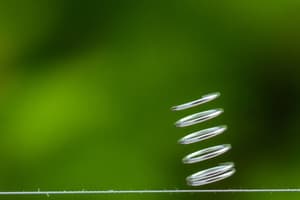Podcast
Questions and Answers
Match the following commercial gravimeters with their corresponding manufacturers:
Match the following commercial gravimeters with their corresponding manufacturers:
LaCoste and Romberg = LaCoste and Romberg Texas Instruments = Texas Instruments Scintex = Scintex Worden Gravity meter = Texas Instruments
Match the following gravity observation techniques with their corresponding descriptions:
Match the following gravity observation techniques with their corresponding descriptions:
Spring-Based Gravimetry = Use elastic spring with a mass suspended to measure gravity Gravity Loop = Gravity observation corrected for static and dynamic drift, earth tide and calibration Optical Method = Method of recording (optical) and magnification (capacitative photo electric) Profile Method = One of the three methods used in field observation
Match the following gravity meters with their corresponding characteristics:
Match the following gravity meters with their corresponding characteristics:
LaCoste and Romberg gravimeter = Accuracy: 0.01 mGal Scintex gravimeter = Resolution: 0.005 mGal Worden Gravity meter = Errors - Spring drift and temperature Texas Instruments gravimeter = Schematic-of-a-La-Coste-Romberg-gravimeter
Match the following gravity observation methods with their corresponding descriptions:
Match the following gravity observation methods with their corresponding descriptions:
Match the following gravity measurement techniques with their corresponding requirements:
Match the following gravity measurement techniques with their corresponding requirements:
Match the following gravity observation errors with their corresponding descriptions:
Match the following gravity observation errors with their corresponding descriptions:
Match the following gravity observation techniques with their descriptions:
Match the following gravity observation techniques with their descriptions:
Match the following gravity units with their equivalent values:
Match the following gravity units with their equivalent values:
Match the following gravity survey methods with their characteristics:
Match the following gravity survey methods with their characteristics:
Match the following gravity meters with their types of observation:
Match the following gravity meters with their types of observation:
Match the following spring-based gravimetry techniques with their descriptions:
Match the following spring-based gravimetry techniques with their descriptions:
Match the following gravity observation apparatus with their types of observation:
Match the following gravity observation apparatus with their types of observation:
Match the following gravity survey networks with their characteristics:
Match the following gravity survey networks with their characteristics:
Match the following gravity units with their equivalent values:
Match the following gravity units with their equivalent values:
Match the following gravity observation techniques with their descriptions:
Match the following gravity observation techniques with their descriptions:
Match the following terms with their definitions:
Match the following terms with their definitions:
Match the following limitations with their corresponding techniques:
Match the following limitations with their corresponding techniques:
Match the following formulas with their corresponding techniques:
Match the following formulas with their corresponding techniques:
Match the following advantages with their corresponding techniques:
Match the following advantages with their corresponding techniques:
Match the following disadvantages with their corresponding techniques:
Match the following disadvantages with their corresponding techniques:
Match the following terms with their corresponding descriptions:
Match the following terms with their corresponding descriptions:
Match the following techniques with their corresponding principles:
Match the following techniques with their corresponding principles:
Match the following errors with their corresponding techniques:
Match the following errors with their corresponding techniques:
Match the following techniques with their corresponding accuracy:
Match the following techniques with their corresponding accuracy:
Flashcards are hidden until you start studying
Study Notes
Gravity Observation Technique
- Gravity observation is used to establish the value of gravity acceleration at a desired point, either through absolute or relative measurements.
Measurement Techniques
- Spring with a mass suspended: uses Hook's Law (mg = k(l - lo)) to measure gravity acceleration.
- Gravity loop: a technique that corrects for static and dynamic drift, earth tide, and calibration.
- There are three methods: Profile method, Star method, and Gravimeters – Absolute and Relative observation.
Commercial Gravimeters
- Examples: LaCoste and Romberg, Texas Instruments (Worden Gravity meter), and Scintex.
- Accuracy: 0.01 mGal, Resolution: 0.005 mGal, Errors: Spring drift and temperature.
Pendulum
- A simple pendulum uses a dimensionless material, suspended on a perfectly flexible, unstretchable, massless string of length L.
- The pendulum's oscillation period (T) is measured to calculate gravity acceleration (g).
- Simple theory, but difficult to implement due to the need for an ideal pendulum and ideal length, with timing accuracy.
Errors in Pendulum Method
- Air friction dampens the pendulum swing and causes buoyancy effects.
- Molecules of air are absorbed on the shaft of the pendulum, changing the length.
- Vibration on the foundation affects the pendulum's rest.
Reversible Pendulum
- Developed by Kater in 1818.
- Uses two pendulums on a fixed axis, but in different directions, with the same oscillation period.
- Removes the impact of vibration.
Falling Body Device
- Observes the motion of a falling body over a distance of 1 or 2 meters.
- Calculates gravity acceleration (g) by eliminating z0 and v0 from three position equations.
Rising and Falling Body
- An improvement over the falling body method.
- Body is thrown upward and then falls freely, passing the same level twice.
- Calculates gravity acceleration (g) by eliminating z0 and v0 from four equations.
Gravity Meter (Gravimeter)
- Uses a static method, measuring gravity acceleration directly.
- Examples: GSS611 Physical Geodesy.
SI Unit for Gravity
- Unit for gravity is Gal or cms-2, named after Galileo Galilee.
- 1 Gal = 1 cms-2 = 10-2 ms-2, 1 mgal = 10-3 gal, 1 µgal = 10-6 cms-2 = 10-8 ms-2.
- Gravity at the equator ≈ 978 Gal = 9.78 ms-2 = 978,000 mgal.
Gravity Datum
- Earliest gravity datum: Potsdam system (Germany, 1906), using reversible pendulums to establish absolute gravity value.
- International Gravity Standardization Net 1971 (IGSN71): replaced Potsdam system, contains 1854 re-occupiable stations worldwide, with an accuracy of ±0.000017gal.
- Peninsular Malaysia Gravity Base Network: 33 stations, accuracy of ±0.005 mGal, with 4 IGSN stations (KL, Penang, Malacca, Singapore) with an accuracy of 0.05 mGal — 0.1 mGal.
Studying That Suits You
Use AI to generate personalized quizzes and flashcards to suit your learning preferences.




